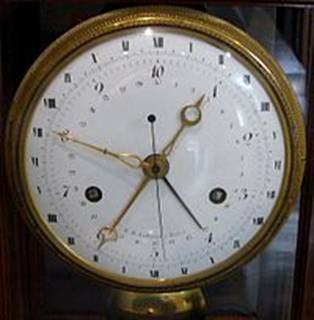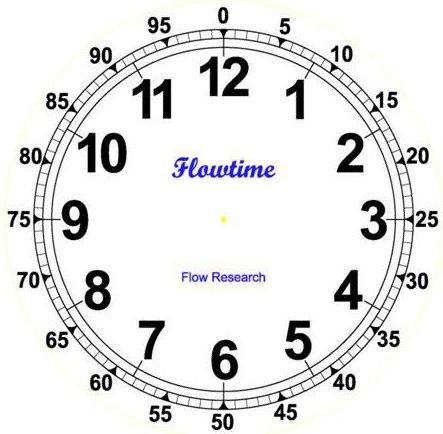Decimal Time
Looking back at the origins of our current time system, as we have seen it dates back to the Babylonians and Egyptians. The Babylonians used mathematics with a base of 60, and divided a circle into 360 degrees. The Egyptians divided hours into 60 minutes and minutes into 60 seconds. They also began measuring time with sundials and water clocks.
Decimal time offers a different picture. While traditional time divides the day into 24 hours, many decimal time systems divide the day into 10 hours. At the same time, decimal time allocates 100 minutes to each hour and 100 seconds to each minute. The two time systems are compared in Table 5-1.
Table 5-1. A Comparison of Traditional Time and Decimal Time
|
Traditional
Time |
Decimal
Time |
|
24 hours per day |
10 hours per day |
|
60 minutes per hour |
100 minutes per hour |
|
60 seconds per minute |
100 seconds per minute |
|
1440 minutes per day |
1000 minutes per day |
|
3600 seconds per hour |
10000 seconds per hour |
 |
Decimal
time has never actually been in effect for a broad population, with the
exception of the experiment tried by the French just after the French
Revolution. On November 24, 1793, the French instituted decimal time
within Unfortunately, people found it very difficult to make the adjustment to decimal time. In addition, replacing every clock and watch in the country proved to be too expensive and too much of a change to keep the new system going, and it lasted only 17 months. Decimal time does have some advantages over traditional time. Forty percent of a 24-hour day is 9.6 hours, or 9 hours and 36 minutes. In decimal time, 40 percent of one 10-day is 4 hours, or 400 minutes. |
|
Figure 5-3. A French Revolutionary Time
Clock showing both traditional time and decimal time in one clock. |
So much of our mathematics is figured on a base ten system that converting fractions to the 24-hour 60- system can be awkward. For example, it is fairly standard in filling out timesheets for payroll to report time in decimal units, e.g. 21.5 hours or 18.75 hours. But 21.5 hours has to be converted to 21 hours and 30 minutes, while 18.75 hours is really 18 hours and 45 minutes for payroll purposes. In a decimal system, 21.5 hours would be 21 hours and 50 minutes, while 18.75 hours would be 18 hours and 75 minutes.
It is interesting that much of the world has
converted to the metric system for weights, volume and measures, but has
resisted the transition to decimal time. In many places except for the
Flowtime: An Alternate System Based on Decimal Time Since “Time Waits for No Man”
Flowtime is a system of decimal time that contains elements of the French decimal time but retains some elements of traditional time. A transition to flowtime would therefore be much easier than the transition the French tried to impose in the late 1700s. In another sense, flow time today is defined as “the period required for completing a specific job or a defined amount of work.” This is a different use of the term “flow time” that is only tangentially related to the use of the term “flowtime” in this chapter.
It is surprising that after 3,300 years, we are still operating on a system of time that was invented long before technology and 2,600 years before the invention of mechanical clocks (around 1300). Today we have many reasons to divide time into smaller and smaller units. Flowtime recognizes this, and it offers a system of time that harmonizes much better with our numbering systems in other areas of life. Most of these are based on the idea of ten. Decimal systems are intuitive because people find counting to ten on their fingers to be intuitive.
The proposal for flowtime is to switch the counting of minutes and seconds from 60 divisions to 100 divisions. This proposal does not include any change in the number of hours per day. It only proposes to increase the number of minutes in one hour from 60 to 100. Likewise, it increases the number of seconds in a minute from 60 to 100.
To easily convert from traditional time to flowtime, take the minutes or seconds in traditional time and multiply by 5/3 or 1.67. The result is the minutes or seconds in flowtime. The hour remains the same.
Another easy way to make the conversion is as follows: Take the minutes or seconds in traditional time and multiply that figure by 2/3. Then add that value to the traditional time value, and you have the flowtime value. For example, if it’s 1:15, take 2/3 of 15, which is 10. Add 10 to 15, and you have the flowtime of 1:25.
What are the implications of this? It means that, under flowtime, instead of the time being 1:30 pm, it will be 1:50 pm. Instead of 3:45 pm, the time will be 3:75 pm.

Why Change to Flowtime?
There are several good reasons for changing to flowtime:
1. Flowtime divides time up into smaller quantities. Instead of 60 minutes per hour, there are now 100 minutes. Instead of 1440 minutes per day, there are now 2400 minutes per day. Instead of 3600 seconds in one hour, there are now 10,000 seconds per hour. Having smaller units of time to deal with makes it possible to break tasks down into more discrete periods.
2. The advent of digital time makes the base 60 method of measuring time obsolete. When the only types of clocks were analog clocks, base-60 type clocks made more sense. With the advent of digital clocks, counting down from one minute 20 seconds to 59 seconds introduces a gap as the time reaches the one-minute mark. It would be more intuitive to go from 101 to 100 to 99 seconds than to go from 1 minute 1 second to 1 minute 0 seconds to 59 seconds.
3. Flowtime provides a more fine-grained analysis of time for sporting events. A basketball or football game played on flowtime would have that many more time units built into it. While it will not actually make the game last longer, the possibility for additional plays is increased because the unit of time is smaller. In fact, at National Basketball Association (NBA) games, as the clock winds down, the seconds get divided into ten equal segments. As a result, if a foul occurs with 0.3 seconds left on the clock, it is possible to stop play at that point. If the second were not subdivided into ten equal parts, no one would know exactly how much time was left. With this form of decimal time in place, players know they may still have time for a “catch and shoot” play after they get the ball. The same idea applies in daily life.
4. The advent of computers and other time-oriented equipment makes it necessary to measure time in ever smaller chunks. Computer time is now measured in nanoseconds. While we don’t need to measure our ordinary time in nanoseconds, flowtime gives the option of having a more fine-grained analysis of time.
5. Many time accounting systems are based on decimal time. As has already been noted, timesheets are often made out in a form of decimal time.
6. Here’s an analogy that will help explain the value of flowtime. Some coffeepots have markings for 2, 4, 6, 8 and 10 cups. For someone who wishes to make 5 cups, it would be helpful also to have markings for 3, 5, 7, and 9 cups, so it isn’t necessary to estimate what is halfway between 4 and 6. Flowtime is like a coffeepot with extra markings - it enables you to measure time to a higher degree of precision.
7. Also imagine measuring with a ruler that only has the 1/4 inch and 1/2 inch markings on it. If you want to measure something that is 4 3/8 inches, you will have to estimate the halfway point between 4 1/4 and 4 1/2. If you then switch to a ruler that has the 1/8 and 1/16 points marked off, you can make a more precise measurement. Flowtime is like a ruler of time that gives you more precision than our current time system.
Where’s the payoff in this switch to flowtime? Why does it matter what time system we use as long as everyone has the same one? The payoff in switching to flowtime is that when you switch to flowtime, you will have the tools for becoming more productive. The reason is quite simple. Because you are working with smaller time units, you have the potential to achieve greater precision in the measurement of time.
Someone who gives himself one hour to complete a series of tasks, such as writing five letters, is less likely to get them done than someone who gives himself 12 minutes to complete each letter, and monitors how long each letter takes. The first person is likely to find himself rushing at the end to complete the five letters, unless he paces himself along the way. Under flowtime, the same person can allocate 20 minutes to each letter. Of course, the duration of 12 minutes of traditional time is the same as the duration of 20 minutes of flowtime, so flowtime may not be that much of an advantage in this case.
On the other hand, consider the example of someone that has 25 things to do in an hour, such as getting 25 letters ready to mail. To accomplish this, each letter has to take about the same amount of time, including signing the letter, writing a note, putting in the inserts and sealing the envelope. Under traditional time, our letter writer has 2.4 minutes for each letter. However, under flowtime, he has 4 minutes per letter. If he has access to a flowtime clock, he can easily track his progress by the flowtime clock. With a traditional clock, he would have to approximate the time each letter takes. In this case, flowtime provides an advantage by dividing time into smaller units, even though the duration of time remains the same.
The advantage of flowtime was driven home to me again one evening while watching a National Basketball Association (NBA) game. There were 3.5 seconds left. The commentator said “The coach wants to know exactly how much time is left so he knows what plays he can run.” When the game is on the line, the coach has a choice of plays he can run to try to score a goal in a very limited period of time. One might take 3.1 seconds, while another might take 3.9 seconds. Because he knows that there are exactly 3.5 seconds left, he knows to call a play that can be completed in 3.5 seconds or less. Without the decimal time clock, he would only know that there are somewhere between 3 and 4 seconds left in the game, but he wouldn’t know exactly how much time is left.
By dividing time into smaller units, flowtime enables us to determine more exactly how much time is available, when this is desirable. And the change can be made without abandoning the 24 hour day, unlike French Revolutionary Time, which called for a 10 hour day.
READ MORE ABOUT FLOWTIME AT WWW.FLOWTIME.ORG
 |
Flow Research, Inc. 27 Water Street Wakefield, MA 01880 (781) 245-3200 (781) 224-7552 (fax) info@flowresearch.com |